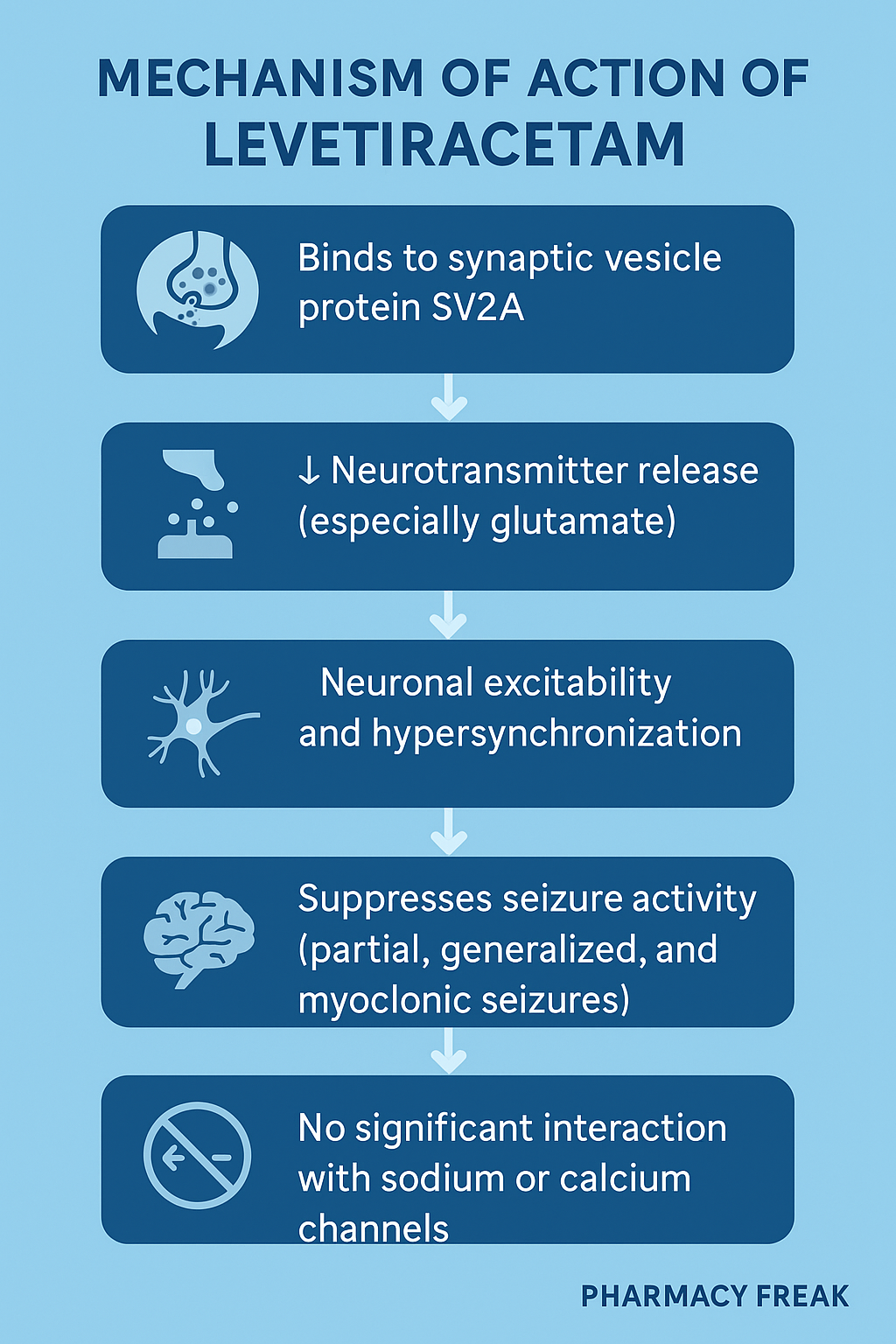Table of Contents
Introduction
Levetiracetam is a novel, broad-spectrum antiepileptic drug (AED) used in the treatment of partial seizures, myoclonic seizures, and generalized tonic-clonic seizures. It is known for its favorable safety profile, minimal drug interactions, and ease of use in both adults and pediatric patients. Unlike older AEDs, levetiracetam acts through a unique synaptic mechanism.
It is frequently tested in USMLE, NCLEX, GPAT, and NEET-PG due to its distinct pharmacology and clinical application.
Stepwise Mechanism of Action of Levetiracetam
- Binding to Synaptic Vesicle Protein 2A (SV2A)
Levetiracetam binds to SV2A, a protein found on synaptic vesicles, which modulates neurotransmitter release and synaptic transmission. - Modulation of neurotransmitter release
Through SV2A interaction, it reduces presynaptic glutamate release and enhances GABAergic inhibition, leading to overall suppression of neuronal hyperactivity. - Inhibition of N-type calcium channels
It also inhibits N-type voltage-gated calcium channels, which contributes to decreased neurotransmitter exocytosis. - Inhibition of high-voltage action potentials
Levetiracetam decreases high-voltage neuronal discharges, stabilizing neuronal activity during seizures.

Pharmacokinetic Parameters of Levetiracetam
| Parameter | Value |
|---|---|
| Bioavailability | ~100% (oral) |
| Half-life | 6–8 hours |
| Protein binding | <10% (very low) |
| Metabolism | Minimal hepatic metabolism (non-CYP) |
| Excretion | Renal (~66% unchanged) |
| Therapeutic range | Not well-defined (typical dose: 500–1500 mg BID) |
Clinical Uses of Levetiracetam
- Focal (partial) seizures
- Myoclonic seizures (Juvenile Myoclonic Epilepsy)
- Generalized tonic-clonic seizures
- Status epilepticus (off-label)
- Seizures in neonates and elderly
- Adjunctive therapy for refractory epilepsy
Adverse Effects of Levetiracetam
- Somnolence and dizziness
- Irritability and mood changes
- Fatigue
- Depression or suicidal thoughts (rare but monitored)
- Behavioral abnormalities (esp. in children)
- Headache
- Rash (rare)
⚠️ Generally well tolerated and preferred due to low drug-drug interaction potential.
Comparative Analysis: Levetiracetam vs Phenytoin
| Feature | Levetiracetam | Phenytoin |
|---|---|---|
| MOA | SV2A modulation | Na⁺ channel blocker |
| Drug interactions | Minimal | Many (CYP450 inducer) |
| Monitoring | Rarely needed | Therapeutic drug monitoring needed |
| Side effects | Behavioral changes | Gingival hyperplasia, hirsutism |
| Use in pregnancy | Safer | High teratogenic risk |
Practice MCQs
Q1. The primary molecular target of levetiracetam is:
a. Sodium channels
b. GABA-A receptors
c. SV2A protein ✅
d. AMPA receptors
Q2. Levetiracetam modulates neurotransmission by:
a. Enhancing glutamate
b. Blocking serotonin
c. Suppressing glutamate release ✅
d. Activating dopamine
Q3. What is a key benefit of levetiracetam over other AEDs?
a. Strong sedation
b. High protein binding
c. Minimal drug interactions ✅
d. Autoinduction of enzymes
Q4. Levetiracetam is excreted primarily via:
a. Liver
b. Kidney ✅
c. Lungs
d. Skin
Q5. Which of the following is a common side effect of levetiracetam?
a. Hepatitis
b. Gingival hyperplasia
c. Behavioral changes ✅
d. Alopecia
Q6. In which seizure type is levetiracetam used first-line?
a. Absence seizures
b. Myoclonic seizures ✅
c. Febrile seizures
d. Psychogenic seizures
Q7. SV2A is located in:
a. Nucleus
b. Axon hillock
c. Synaptic vesicles ✅
d. Postsynaptic membrane
Q8. Levetiracetam affects which calcium channels?
a. T-type
b. L-type
c. N-type ✅
d. P/Q-type
Q9. Can levetiracetam be used in status epilepticus?
a. Never
b. Yes, off-label ✅
c. Only in children
d. Only with benzodiazepines
Q10. Which AED is safest for elderly patients due to low interaction profile?
a. Phenytoin
b. Carbamazepine
c. Levetiracetam ✅
d. Phenobarbital
FAQs
Q1: Does levetiracetam cause sedation?
Yes, mild sedation is possible, especially in early stages.
Q2: Is therapeutic drug monitoring required?
Not usually. It has a wide therapeutic window.
Q3: Can it be used as monotherapy?
Yes, for partial and generalized seizures.
Q4: Is levetiracetam safe in pregnancy?
Considered relatively safe, but always under physician supervision.
Q5: What makes it suitable for elderly and polypharmacy patients?
Minimal hepatic metabolism and no CYP450 induction make it ideal.
References
- KD Tripathi – Essentials of Medical Pharmacology
- Goodman & Gilman – The Pharmacological Basis of Therapeutics
- Review of Pharmacology – Sparsh Gupta
- NCBI: https://www.ncbi.nlm.nih.gov/books/NBK519567/

I am pursuing MBA in pharmaceutical management from NIPER Hyderabad with a strong academic record and proven success in national-level pharmacy entrance exams. I secured AIR 61 in NIPER 2024 (MS/M.Pharm) and AIR 27 in NIPER MBA, along with AIR 147 in GPAT 2024 and AIR 907 in GPAT 2023. I also achieved AIR 6 in AIIMS CRE-2025 for Drug Store Keeper and was selected as a Pharmacist (AIR 61) for ESIC. Additionally, I was the Runner-Up in Round 2 of the EY Case Study Competition.
At PharmacyFreak.com, I aim to guide future pharmacists through expert content, exam strategies, and insightful resources based on real experience and academic excellence.
Mail- harsh@pharmacyfreak.com
